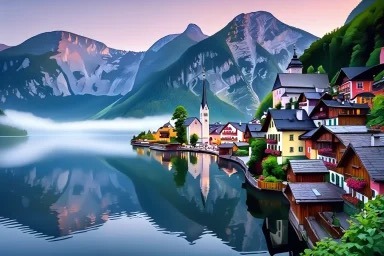Hallstatt: Austria’s Lakeside Daydream that Accidentally Went Viral
You’ll find Hallstatt in the Salzkammergut region of Upper Austria, about 90 minutes from Salzburg or 3 hours from Vienna - unless you get distracted by a mountain, which is statistically likely. It’s wedged between the Hallstätter See and a near-vertical cliff, which explains both its postcard-worthy topography and the slight air of “should this even be structurally possible?”
ECHOES OF ELSEWHEREEUROPEAUSTRIAUNESCONATUREMOUNTAINSLAKEVILLAGES & TOWNSCULTURE


Salzkammergut, Upper Austria
Some places feel like they were designed by someone who had never seen the real world - but had read every fairy tale, watched every Wes Anderson film, and thought, “More swans. Definitely more swans.”
Enter Hallstatt.
Tucked between the glassy Hallstätter See and the Dachstein Alps, this tiny Austrian village seems to have been airbrushed by angels. Pastel houses cling to the mountain’s edge, swan boats drift silently across the lake, and church steeples pierce the sky like exclamation points in a landscape otherwise too peaceful to shout. It’s quaint. It’s cinematic. It’s suspiciously photogenic.
And it’s old - prehistorically old. Like “people were mining salt here before Rome was a concept” old. Whether you stumbled upon it on a Pinterest board, saw it on a screensaver, or mistakenly thought it was a movie set (you’re not alone), welcome to the place that made “Austrian lake town” an international mood.
Where Is Hallstatt (and Why Is It So Ridiculously Perfect)?
You’ll find Hallstatt in the Salzkammergut region of Upper Austria, about 90 minutes from Salzburg or 3 hours from Vienna - unless you get distracted by a mountain, which is statistically likely.
It’s wedged between the Hallstätter See and a near-vertical cliff, which explains both its postcard-worthy topography and the slight air of “should this even be structurally possible?”
Getting there can involve:
Driving (parking outside the village, because cars inside = nope),
Taking a train to Hallstatt station, then hopping on a boat across the lake, which is possibly the most poetic approach to any village, ever.
A Village That Invented Salt Chic
“Hallstatt” literally means place of salt, and for over 7,000 years, the locals have been pulling white gold from the surrounding mountains. If you’re the sort who likes your history buried in minerals and mist, the Hallstatt Salt Mine is your holy grail.
Take the funicular up to the mine entrance, explore subterranean salt tunnels, learn about Bronze Age pickaxes, and then - because this is Hallstatt - slide down a 64-meter wooden chute like an Alpine child on holiday.
Outside the mine, you’ll find the Skywalk, a suspended viewing platform that offers a 360-degree panorama of the lake, the village, and your suddenly irrelevant Instagram feed.
Things to Do in Hallstatt (Besides Staring Blankly at Its Beauty)
1. Stroll Through the Village (Slowly, and with Frequent Sighs)
The main attraction here is… the village itself. Wander narrow streets lined with geranium-draped balconies, peek into local craft shops, sip Austrian coffee with cake so rich it needs its own bank account, and resist (or don’t resist) photographing everything twice.
2. Visit the Bone House (Beinhaus)
Behind the picture-perfect Catholic church lies a tiny chapel with a less Instagrammed claim to fame: over 600 painted skulls, neatly stacked and decorated with floral motifs. It’s eerie, elegant, and extremely Austrian.
3. Rent a Swan Boat or Paddle Across the Lake
Sure, you could hike or cycle. But there’s something profoundly poetic about paddling a swan-shaped boat past an Alpine village so pretty it’s been cloned by the Chinese (yes, really - see: Hallstatt, China).
4. Explore the Market Square
The Marktplatz is as charming as it sounds - lined with historic inns, cafes, and shops selling everything from salt lamps to hand-carved souvenirs. The square also hosts concerts, festivals, and spontaneous outbreaks of accordion music.
5. Hike the Echerntal Valley
For those who like their fairy tales with a bit of mud and altitude, trails through Echerntal lead to glacial formations, waterfalls, and the kind of landscapes that make you feel like an unpaid extra in The Sound of Music.
When to Visit Hallstatt
Spring (April–June): Flowers, mild weather, and the sound of melting snow trickling from the mountains.
Summer (July–August): Peak season. The village gets crowded, but oh - the lake is turquoise, and the days last forever.
Autumn (September–October): Absolute magic. Golden forests, misty mornings, and fewer tourists. Bring a light scarf and a heavy camera.
Winter (November–February): Quiet, chilly, and possibly snow-dusted. Think: Hallstatt with Christmas vibes, minus the crowds.
What to Bring (Besides Your Most Delicate Sigh)
Comfortable walking shoes – cobblestones are charming, but your ankles will need support
Camera with zoom lens – especially if you’re taking the boat
A light jacket – the weather has the attention span of a sparrow
Cash and card – most places take cards, but some schnitzel stalls don’t
An off-season attitude – if you visit in summer, embrace the crowds with stoicism and strudel
Fun Facts You’ll Definitely Tell Someone Later
It’s been inhabited since the Iron Age. Hallstatt gave its name to an entire era of European history: the Hallstatt Culture (800–400 BC). No big deal.
The Chinese built an exact replica in Guangdong province. Which is flattering. And only slightly creepy.
Hallstatt is car-free for visitors - so the air is as fresh as the visuals.
It’s a UNESCO World Heritage Site, because of course it is.
You can rent a traditional boat called a “Plätte”, and pretend you’re delivering salt while whispering philosophical thoughts about time and tourism.
Final Thought: Hallstatt Isn’t Just a Village - It’s a Feeling
There are places that you take photos of, and there are places that photograph your soul. Hallstatt is the latter.
Whether you’re sipping coffee by the lake, admiring a baroque church on a foggy morning, or standing on the Skywalk thinking “this is too good to be legal,” Hallstatt casts a quiet spell. It doesn’t shout to impress. It simply exists - perfectly balanced between history, water, and the weight of its own surreal beauty.
So come for the views. Stay for the silence. Leave with the unsettling feeling that no place back home will ever quite measure up.




